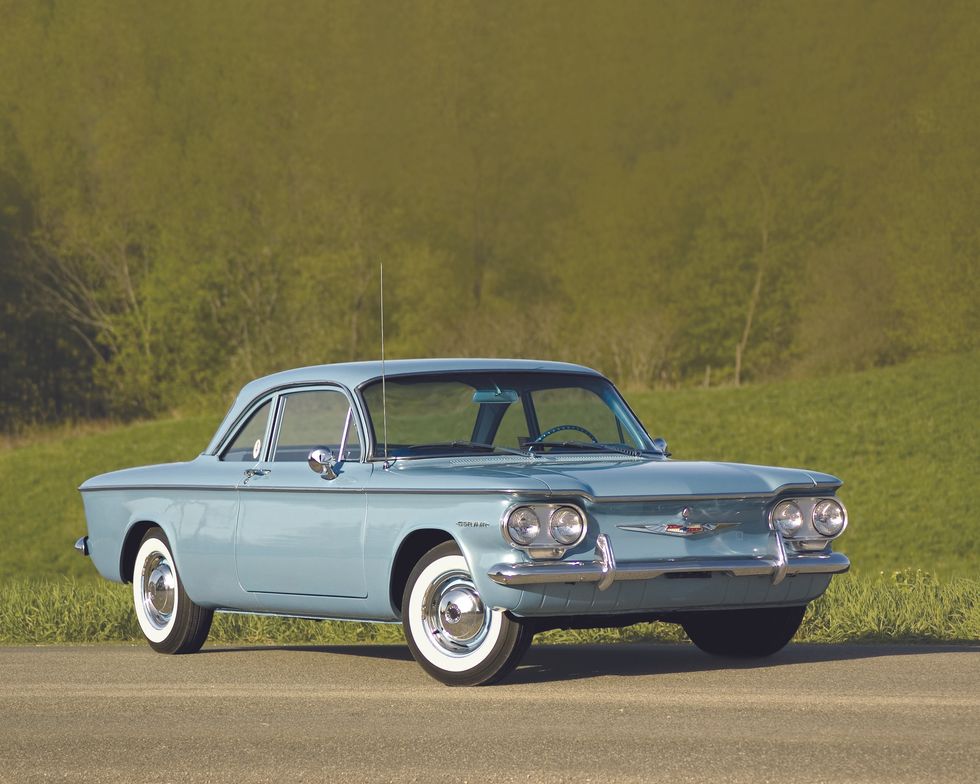
THE 1960 CHEVROLET CORVAIR 700 WAS A TECHNOLOGICAL TOUR DE FORCE
This is where the Corvair story started. Long before the hot Spyder and the hotter Corsa, before even the sporty Monza, there was the Corvair 700. The purest expression of Chevrolet chief Ed Cole’s vision for a revolutionary, air-cooled economy car, the 700 and its bare-bones stablemate, the 500, represented the entire Corvair lineup when the curtain was raised in October 1959. Once overlooked by collectors in favor of later, flashier versions of the Corvair, the first-year 500 and 700 are now appreciated as reminders of the car's original mission: to push back the rising tide of Volkswagens.
When the Corvair went on sale on October 2, 1959, it was the first American compact with a rear-mounted, air-cooled engine, a feature that Chevrolet had played up in the months leading up to the model’s introduction. Without mentioning the competition by name, promotional materials pointed out the car's advantages over the VW: unit-body construction, three-across seating, a smooth six, and the availability of an automatic transaxle—in fact, the two-speed Powerglide was going to be the car's only transmission until Cole was persuaded to add a three-speed manual to the mix. Only four-door sedans were available at first; coupes joined the lineup in January 1960.
The 80-hp, 140-cu.in. opposed-six was used only in 1960. A duct brought warmed air from around cylinder number 6 into the air cleaner to cure carburetor icing problems.Photo: David LaChance
Though it was inspired by Volkswagen’s flat-four, the Corvair’s opposed six-cylinder owed nearly nothing to its German rival. Chevrolet engineers used four-cylinder Porsche engines to determine operating temperatures for various components but were on their own in working out the particular challenges of a flat-six configuration—primarily those of intake, exhaust and cooling. Engine blocks and cylinder heads were die-cast of aluminum alloy, while individual cylinder barrels were of iron. Cooling was achieved through a top-mounted horizontal fan, driven by a long rubber belt that made a 90-degree bend around the alternator and idler pulleys. The six displaced 140 cubic inches, nearly double that of its Wolfsburg rival; the Corvair’s displacement would grow to 145-cu.in. the next year, and to 164-cu.in. in 1964.
Four-wheel independent suspension was by coil springs, with swing axles in the rear and A-arms up front. Brakes were unassisted drums; power steering was not considered necessary, because the front end of the car was relatively light.
To keep the car competitive with the $1,565 VW, and with the conventionally engineered Falcon and Valiant compacts that Ford and Chrysler were known to have in the pipeline, Chevrolet cut corners right where it showed: on the interior. The 500 models were especially grim, with gray painted metal, gray fabric and vinyl upholstery and black rubber floor mats. The 700s were a bit more cheerful, with three interior colors to choose from. Most things we take for granted today—a passenger-side sun visor, or arm rests—cost extra on both the 700 and the 500.
Instrumentation was limited to a speedometer and a fuel gauge; the optional AM radio needed a few seconds of warmup. On 700s, textured aluminum with chrome trim was featured on the glove compartment door and the instrument bezel, an upgrade from the 500's gray paint.Photo: David LaChance
Chevrolet sold just over 250,000 examples of the Corvair for 1960, boosted by the April introduction of the sporty, bucket-seat-equipped Monza coupe. The line would eventually expand to include convertibles, station wagons, and a forward-control series of vans and light pickup trucks. In all, some 1.8 million examples were built before Corvair production ended in 1969, brought down by factors that included the pony car revolution and a book by a young lawyer named Ralph Nader.
While the first-year Corvair stands as a reminder of what GM engineering could do at the height of its powers, it’s still relatively affordable, with auction prices averaging around $11,000. Over the past three years, 15 have been listed for sale with Hemmings, with asking prices ranging from $10,995 to $57,900. A Club Coupe was sold by RM Sotheby’s for $17,966 in 2023, while the award-winning example shown on these pages is currently advertised on the Hemmings Marketplace with an asking price of $28,500.
Engine: OHV, horizontally opposed six, 139.6-cu.in.
Horsepower: 80 @ 4,400 rpm
Torque: 125 lb-ft @ 2,400 rpm
Transmission: Two-speed Powerglide automatic
Suspension: Front: Independent, A-arms, coil springs, tubular shock absorbers/Rear: Independent, swing axles, coil springs, tubular shock absorbers
Brakes: Hydraulic, 9-inch drum
Wheelbase: 108 inches
Curb weight: 2,359 pounds
Price new: $2,049
Value today: $2,750-$14,300
2024-06-22T16:08:46Z dg43tfdfdgfd